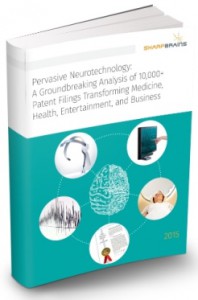Reservoir electrodes for electroencephalograph headgear appliance: Key Neurotech Patent #5
Today we are sharing a 2001 patent assigned to Sedline, Inc. (As mentioned, we are featuring a foundational Pervasive Neurotech patent a day, from older to newer by issue date)
U.S. Patent No. 6,301,493: Reservoir electrodes for electroencephalograph headgear appliance.
- Assignee(s): Sedline, Inc.
- Inventor(s): Dominic P. Marro, Thomas T. Washburn, Denis E. LaBombard
- Technology Category: EEG
- Issue Date: October 9, 2001
SharpBrains’ Take:
While patents in the neurotechnology category of EEG are more frequently being directed towards either EEG signal analysis and/or applications of EEG (e.g., security applications, sleep applications, etc.), the ‘493 patent presents an EEG patent directed towards aspects of the core EEG hardware. The ‘493 patent has a priority date of 1999, when such EEG hardware disclosures began to be less prominent in the patent literature. Despite having just two claims, the ‘493 patent is a key patent at least in part because of the useful inventive concept allowing easy and automatic gel dispensing for wet sensors, as wet sensing often remains a necessary method for securing high fidelity EEG signal detection.
Abstract:
This invention defines a system for monitoring the brain activity of a human patient under anesthesia in order to determine the patient’s level of consciousness. The system uses a plurality of receptors which are mounted in predetermined anatomical positions on the patient’s head. The receptors are secured by adhesive foam patches. The appliance fits snugly to the head with the aid of self-adjusting strip that carry imbedded electrical circuitry for the receptors. Electrical connectivity in locations where scalp hair is most likely to be present is improved by the use of braille-tip electrodes fitted with large gel reservoirs.
Illustrative Claim 1. A receptor for collecting electroencephalographic signals comprising an approximately hemispherical reservoir with pressure opened partially slit flat radially arranged surfaces on the side adapted to be adjacent to the patient’s head and containing electrolytic gel, the hemispherical reservoir being pressed to deploy the electrolytic gel.
 To learn more about market data, trends and leading companies in the digital brain health space –digital platforms for brain/ cognitive assessment, monitoring and enhancement– check out this market report. To learn more about our analysis of 10,000+ patent filings, check out this IP & innovation neurotech report.
To learn more about market data, trends and leading companies in the digital brain health space –digital platforms for brain/ cognitive assessment, monitoring and enhancement– check out this market report. To learn more about our analysis of 10,000+ patent filings, check out this IP & innovation neurotech report.



